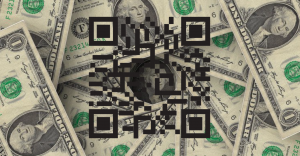Mobile Pay is Booming in China (QR Codes Utilized as Payment Links)
Posted on by Chad DormanSome of the biggest news to come out of China recently is that cash is no longer king. In fact, cold hard dollars and cents are effectively dead there. The Chinese have taken massive steps to live in the financial future by using mobile pay almost exclusively. And, at the crux of mobile pay, is the QR Code – scan the code, pay for your purchase, get on with your day. China and its love affair with mobile pay can be analyzed in four major touch-points:
1. In 2016, mobile payment volume in China doubled to $5 trillion, according to Hillhouse Capital’s Analysis data.
2. In mainland China, both service providers and stores have become increasingly mobile-pay centered around apps such as Alipay and WeChat Pay. In fact, WeChat Pay cornered 40 percent of the mobile payment market, and Alipay took more at 54 percent during one quarter according to an extensive financial study. Alipay is owned by an affiliate of Alibaba’s Ant Financial Services, and it boasts 520 million users on its international website.
3. Mobile pay has grown so fast in mainland China that foreigners can find it quite difficult to go about completing even the most basic transaction without it.
4. Mobile transactions’ dominance in China could also lead to better data collection by their government.
QR Codes Vs. Cash
At one time, when shopping or eating out with local friends, the Chinese consumers would ask a merchant if they accepted credit cards, while now they ask if they accept WeChat Pay or Alipay. Then, they pay simply with the scan of a QR code right at the table or a customer shows a code to a store clerk on their Smartphones. In fact, the Chinese often joke that a beggar would prefer a mobile pay donation to cash.
Spreading to Other Countries
The mobile pay habit that has taken over China has started to trickle in to some other countries. More than six million people from China went traveling abroad last fall for their national holiday called “Golden Week.” That travel – plus China’s change to using mobile payments and QR codes – ended up putting a certain amount of pressure on places like Hong Kong and Japan to start adopting mobile payment services, since they are popular destinations for Chinese tourists. In fact, the total number of stores that accept mobile payments is expected to double to approximately 45,000 stores this year, according to a report from Nikkei.
Major Progress
So, as mobile pay has completely changed the daily commerce in China, an entire society that was once limited only to using bills that were less than 100 Yuan denominations has now become one where QR payment codes are the norm. Since there is very little red tape in China coupled with a financial system that is much less developed, the Chinese have actually managed to surpass most developed world in the practice of readily accepting mobile payments.
300 Trillion Yuan by 2021
According to CLSA, a research investment company in Hong Kong, the volume of Chinese electronic payments could quadruple by the year 2021 all the way up to 300 trillion Yuan. In addition, according to Research, mobile payments in China rose to $5.5 trillion in 2016. That’s approximately 50 times the size of the $112 billion market in the U.S.
For the Chinese imports that the States have brought in over time, the writing is on the wall that mobile-pay, and those QR Codes associated, are only set to grab a larger hold on payment methods other time.
What This Means for Countries Outside of China
While countries such as the United States may not be going completely cashless or cardless in the very near future, the momentum toward a fully digital currency is inevitable. With this, QR codes will remain one of the most practical ways to facilitate such transactions. While it may not be a sexy new technology, QR Codes are reliable, platform independent, and ubiquitous worldwide.


